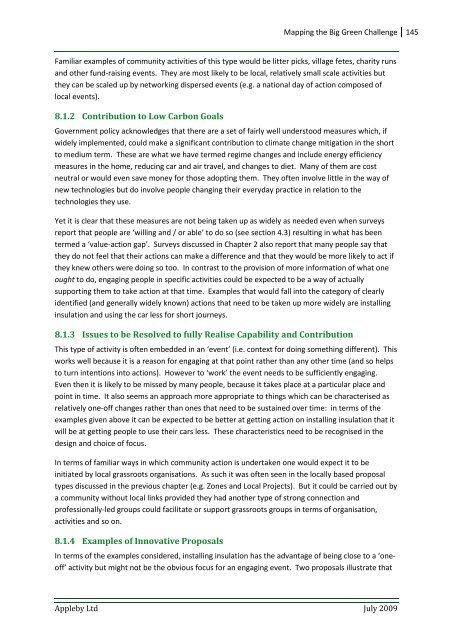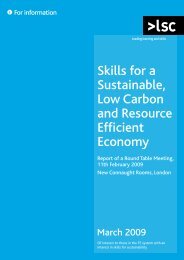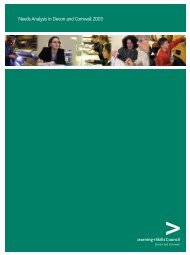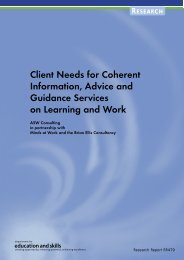Mapping the Big Green Challenge - The Skills & Learning ...
Mapping the Big Green Challenge - The Skills & Learning ...
Mapping the Big Green Challenge - The Skills & Learning ...
Create successful ePaper yourself
Turn your PDF publications into a flip-book with our unique Google optimized e-Paper software.
<strong>Mapping</strong> <strong>the</strong> <strong>Big</strong> <strong>Green</strong> <strong>Challenge</strong> 145Familiar examples of community activities of this type would be litter picks, village fetes, charity runsand o<strong>the</strong>r fund-raising events. <strong>The</strong>y are most likely to be local, relatively small scale activities but<strong>the</strong>y can be scaled up by networking dispersed events (e.g. a national day of action composed oflocal events).8.1.2 Contribution to Low Carbon GoalsGovernment policy acknowledges that <strong>the</strong>re are a set of fairly well understood measures which, ifwidely implemented, could make a significant contribution to climate change mitigation in <strong>the</strong> shortto medium term. <strong>The</strong>se are what we have termed regime changes and include energy efficiencymeasures in <strong>the</strong> home, reducing car and air travel, and changes to diet. Many of <strong>the</strong>m are costneutral or would even save money for those adopting <strong>the</strong>m. <strong>The</strong>y often involve little in <strong>the</strong> way ofnew technologies but do involve people changing <strong>the</strong>ir everyday practice in relation to <strong>the</strong>technologies <strong>the</strong>y use.Yet it is clear that <strong>the</strong>se measures are not being taken up as widely as needed even when surveysreport that people are ‘willing and / or able’ to do so (see section 4.3) resulting in what has beentermed a ‘value-action gap’. Surveys discussed in Chapter 2 also report that many people say that<strong>the</strong>y do not feel that <strong>the</strong>ir actions can make a difference and that <strong>the</strong>y would be more likely to act if<strong>the</strong>y knew o<strong>the</strong>rs were doing so too. In contrast to <strong>the</strong> provision of more information of what oneought to do, engaging people in specific activities could be expected to be a way of actuallysupporting <strong>the</strong>m to take action at that time. Examples that would fall into <strong>the</strong> category of clearlyidentified (and generally widely known) actions that need to be taken up more widely are installinginsulation and using <strong>the</strong> car less for short journeys.8.1.3 Issues to be Resolved to fully Realise Capability and ContributionThis type of activity is often embedded in an ‘event’ (i.e. context for doing something different). Thisworks well because it is a reason for engaging at that point ra<strong>the</strong>r than any o<strong>the</strong>r time (and so helpsto turn intentions into actions). However to ‘work’ <strong>the</strong> event needs to be sufficiently engaging.Even <strong>the</strong>n it is likely to be missed by many people, because it takes place at a particular place andpoint in time. It also seems an approach more appropriate to things which can be characterised asrelatively one-off changes ra<strong>the</strong>r than ones that need to be sustained over time: in terms of <strong>the</strong>examples given above it can be expected to be better at getting action on installing insulation that itwill be at getting people to use <strong>the</strong>ir cars less. <strong>The</strong>se characteristics need to be recognised in <strong>the</strong>design and choice of focus.In terms of familiar ways in which community action is undertaken one would expect it to beinitiated by local grassroots organisations. As such it was often seen in <strong>the</strong> locally based proposaltypes discussed in <strong>the</strong> previous chapter (e.g. Zones and Local Projects). But it could be carried out bya community without local links provided <strong>the</strong>y had ano<strong>the</strong>r type of strong connection andprofessionally-led groups could facilitate or support grassroots groups in terms of organisation,activities and so on.8.1.4 Examples of Innovative ProposalsIn terms of <strong>the</strong> examples considered, installing insulation has <strong>the</strong> advantage of being close to a ‘oneoff’activity but might not be <strong>the</strong> obvious focus for an engaging event. Two proposals illustrate thatAppleby Ltd July 2009











